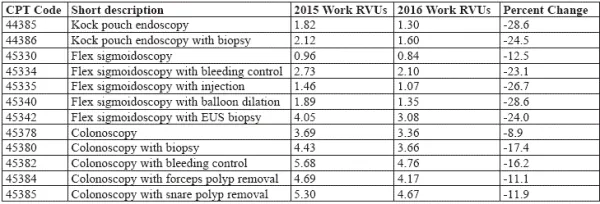General Surgery Coding Alert
Beware 2016 Fee Changes That Could Slash Your Pay
Check out these steep endoscopy cuts.
The Medicare Physician Fee Schedule (MPFS) final rule is out, and we have some news that will impact your general surgery practice.
Good news: With the Sustainable Growth Rate (SGR) annual adjustment gone, you’re not facing across-theboard double-digit pay cuts as you have in past years.
Bad news: With a one percent target for MPFS reductions due to misvalued codes, general surgery practices that perform endoscopies will take a big hit in pay for those services.
Read on to see what’s in store for you 2016 general surgery Medicare pay.
Understand Misvalued Code Updates
In the Protecting Access to Medicare Act of 2014 (PAMA), Congress set a target for adjustments to misvalued codes in the fee schedule for calendar years 2017 through 2020, with a target amount of 0.5 percent of the estimated expenditures under the MPFS for each of those four years. Subsequently, the Achieving a Better
Life Experience Act of 2014 (ABLE) accelerated the application of the target by specifying it would apply for calendar years 2016 through 2018, and increasing the target to 1 percent for 2016.
If the net reductions in misvalued codes in 2016 are not equal to or greater than 1 percent of the estimated expenditures under the fee schedule, a reduction equal to the percentage difference between 1 percent and the estimated net reduction in expenditures resulting from misvalued code reductions must be made to all PFS services.
Watch surgery: The MPFS deals with some potentially misvalued surgery codes that CPT® and the update relative value unit advisory committee (RVUAC) will re-examine and make fee recommendations for, according to Michael A. Ferragamo, MD, FACS, clinical assistant professor at the State University of New York at Stony Brook.
Suck Up These Endoscopy Losses
Despite the fact that CMS’s “Estimated Impact On Total Allowed Charges By Specialty” (Table 62 in the Final Rule) indicates that general surgery can expect a 0 percent impact, that may not be true for your practice.
The same table shows gastroenterology with the largest expected payment reduction of any specialty, at negative 4 percent. If your general surgeons perform a high volume of gastrointestinal (GI) endoscopy services, you might suffer losses in your practice, too.
Here’s why: Many endoscopy codes in the range 44385 to 45398 are on CMS’s list of “potentially misvalued codes.” For 2016, CMS is implementing payment reductions for many of these codes. Table 1 chronicles some of the steepest cuts to the most common procedures that your surgeon might face in this code range. Compare the table to your practice’s procedure volume to see how these changes might impact your bottom line.
Expect Conversion Factor Reduction
Despite the fact that surgeons who perform endoscopies stand to suffer huge pay cuts for certain services, CMS didn’t meet the 2016 one percent goal for misvalued-code payment reductions ordered by Congress. In fact, CMS estimated the CY 2016 net reduction in expenditures resulting from adjustments to relative values of identified misvalued codes to be 0.23 percent. To make up the difference, CMS will reduce the conversion factor by 0.77 percent.
Tip: The conversion factor (CF) is the multiplier that payers apply to relative value units (RVUs) to come up with the dollar payment amount for services. A change to the CF will therefore impact payments across the board for all services, whether or not the fee schedule alters the RVUs for a particular procedure.
That’s not all: CMS also has a mandate for a 0.5 percent scheduled annual increase as part of the Medicare Access and CHIP Reauthorization Act (MACRA), and a 0.02 percent reduction required by budget neutrality. Combine those with the -0.77 update, and that “leads to a net decrease of 0.3% to the 2016 Medicare conversion factor, with the Final Rule publishing a 2016 CF of $35.8279, says Michael A. Granovsky, MD, FACEP, CPC, President of LogixHealth, a national coding and billing company based in Bedford, MA. That’s compared to the 2015 CF of 35.9335.
Related Articles
General Surgery Coding Alert
- Integumentary Procedures:
4 Questions Focus Your Skin Substitute Graft Coding
Hint: Graft size doesn’t matter. If your surgeon treats burn victims, trauma patients, or others [...] - Medicare Physician Fee Schedule:
Beware 2016 Fee Changes That Could Slash Your Pay
Check out these steep endoscopy cuts. The Medicare Physician Fee Schedule (MPFS) final rule is [...] - ICD-10:
Results Are In--Few Glitches Reported So Far
CMS reports 90 percent claims acceptance rate. If your general surgery practice is experiencing what [...] - You Be the Coder:
Account for Both EGD and Blockage Removal
Question: The surgeon performed an EGD with positioning and securing of jejunostomy tube. His findings [...] - Reader Question:
Understand Hernia Details for ICD-10 Code Selection
Question: Our surgeon met with a 57-year-old patient complaining of severe pain around the umbilical [...] - Reader Question:
Determine PFSH for E/M Choice
Question: I have a surgeon’s note for an office visit that clearly indicates a comprehensive [...] - Reader Question:
Avoid ICD-9 and ICD-10 on Single Claim
Question: The surgeon admitted a patient at the end of September and completed the patient [...]




